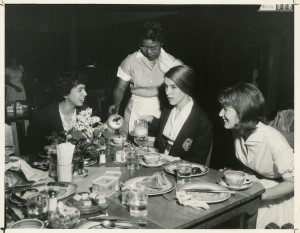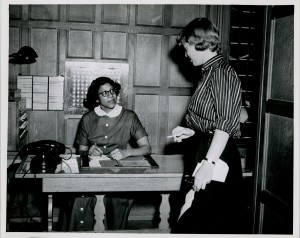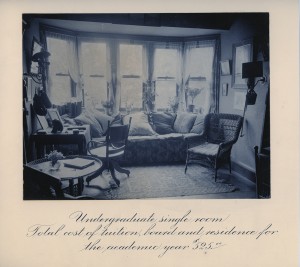We have previously referred to the maids and porters who worked at Bryn Mawr College in other posts and here we reflect more on their presence and significance at the college as part of our celebrations 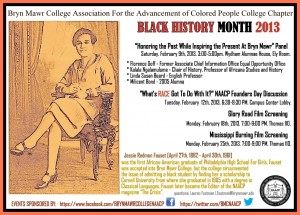 of Black History Month at Bryn Mawr College. If you haven’t already, make sure to check out the Tri-Co Chapter of the NAACP on Facebook and on Tumblr for details of their events throughout the month of February. We have been working with them to assist in their research and their exciting program should not be missed.
of Black History Month at Bryn Mawr College. If you haven’t already, make sure to check out the Tri-Co Chapter of the NAACP on Facebook and on Tumblr for details of their events throughout the month of February. We have been working with them to assist in their research and their exciting program should not be missed.
We are interested in the campus as a space, one that housed different groups across the years and one that is often remembered due to its distinctive architecture and beautifully kept grounds. In thinking more about campus communities and space, it seemed appropriate to examine what evidence we had on those who were integral to maintaining it: maids and porters, the majority of whom historically were African American.
One finding we have made from the research we have conducted at The Albert M. Greenfield Center for the History of Women’s Education on maids and porters at the college is that despite the fact that they were often incredibly close to the students, they rarely feature in the memorializing students did of their lives here. Why is this? Were they so fundamental to the experience of living in the dorms that it was almost too obvious to acknowledge their presence in their reminiscences? Were many maids and porters shy about getting their photos taken? How would they describe their experiences if we could speak with them today? Although we have many questions, we do know, however, through scrapbook evidence, that the maids and porters produced a theatrical show every year and the College Archives contain some photographs of the ways in which students and maids and porters interacted in the dorms.
We also know that there was a night school, a Sunday School and a Maid’s Club which offered classes to interested maids. The Maid’s Club kept a library in their club room and it was reported in the College News of November 15, 1922 that the maids were ‘particularly enthusiastic about singing’ and often sewed while they met (see Offerings to Athena page 103 for more on maids at Bryn Mawr).
Jen Rajchel’s exhibit on our site examines dorm cultures at Bryn Mawr and Jessy Brody’s work on scrapbooks has revealed their virtual absence from the photograph albums and scrapbooks she reviewed – over one hundred in total – that span the late nineteenth and early twentieth centuries. This is despite the fact that students and the staff who looked after their domestic needs in dorms across campus had multiple daily interactions, either in person or through the transmission of goods or services. Seeking out their experiences has required a little more detective work and a stronger reliance on source material from oral histories, memoirs and personal letters, rather than traditional documentary sources that can be used in the construction of ‘important’ historical figures, or those who maintained personal archives.
One such example is a wonderful interview with Fleta Blocker, which you can listen to in its entirety here. Blocker began at the college as a bell maid, a position that revolved around answering the telephone in dormitories, but she progressed in her roles at the college, ending her four-decade career as a Hall Manager, a role previously only held by white women. Her life was rich and full: active in her church, she traveled the world, inspired by the Bryn Mawr environment to see places such as Oxford and Africa. 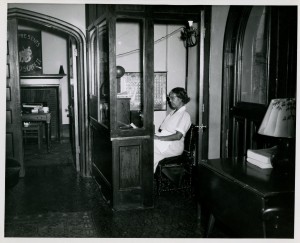 We included a link to this interview in the new exhibition Taking Her Place at the Rare Book Room Gallery in Canaday Library (on view until June 2nd 2013) in the Broadening the World of Bryn Mawr section, as there was a connection between maids at the college and the women who attended the Summer School for Women Workers. (A digital exhibit on the latter group is coming to the site soon!) The women at the Summer School, many of whom worked in poor conditions in factories across America, were moved to complain about the living conditions they saw the maids had, living in the attics of dorms without proper ventilation in the heat of summer. This was an issue that resurfaced again and the ‘living in’ arrangement was eventually phased out.
We included a link to this interview in the new exhibition Taking Her Place at the Rare Book Room Gallery in Canaday Library (on view until June 2nd 2013) in the Broadening the World of Bryn Mawr section, as there was a connection between maids at the college and the women who attended the Summer School for Women Workers. (A digital exhibit on the latter group is coming to the site soon!) The women at the Summer School, many of whom worked in poor conditions in factories across America, were moved to complain about the living conditions they saw the maids had, living in the attics of dorms without proper ventilation in the heat of summer. This was an issue that resurfaced again and the ‘living in’ arrangement was eventually phased out.
We also learned from an interview with alum Jane Drucker (whose interview, along with many others, will be available later this year on the Tri-Co digital repository Triptych), that it was a student rather than a member of the staff who headed the Maids and Porters Association for their dorm. This was not a staff association as such, and Drucker recalls her main responsibility as being to organize end of year gifts for the staff who looked after her dorm. It was not, therefore, despite its name, an association to advocate for staff. Looking back, Drucker thought this was odd, but at the time it was the norm that women students would fulfill such a role.
Photographs of the work that maids and porters did, however, are a feature of the college archive collections and many personal scrapbooks and photograph albums. The immaculately kept dorm rooms appear regularly in scrapbooks, catalogs and what appear to be college commissioned photographs so their importance in the life of the college cannot be underestimated. Many of the photographs show elaborately decorated rooms that imitate parlors in houses where ladies would sit; it is obvious that much effort has been put into creating environments that are comfortable and appropriate for college women. It’s worth considering, therefore, the people who worked to maintain such homely environments.
At The Albert M. Greenfield Digital Center for the History of Women’s Education we are interested in representing the diversity of experiences in education and illuminating the world of women at Bryn Mawr and other colleges in the past. Examining the lives of those who helped them to focus more intently on the ‘life of the mind’ rather than domestic concerns is another angle of vision on past worlds. As we uncover more information through our research activities, we will be adding it so keep watching the site. In the meantime, this great timeline about the “Invisible Women” in domestic service in US history created by Mother Jones is well worth visiting.
Finally, if you have memories you would like to share or any comments, make sure to add them below!

